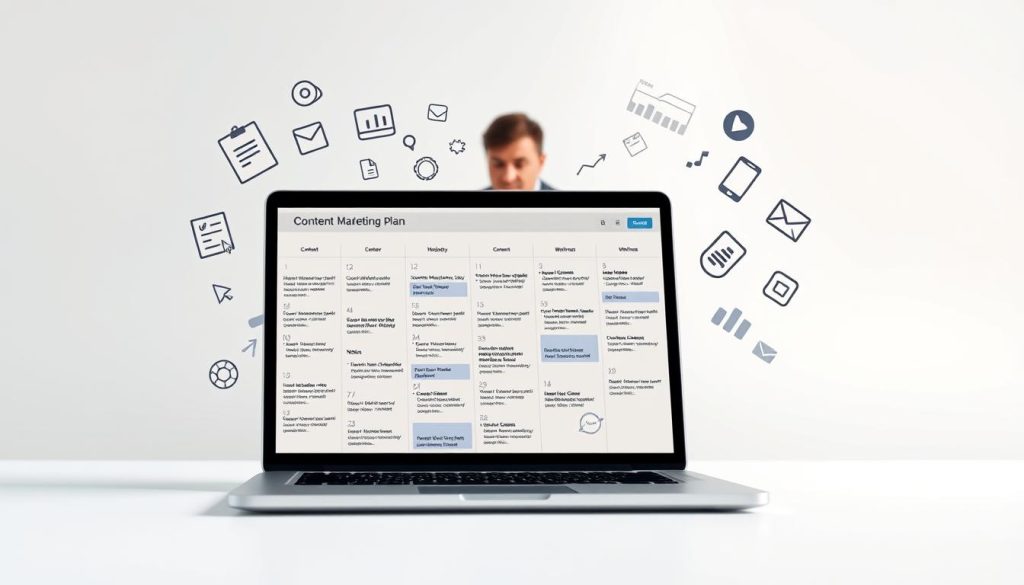Remember that first moment you decided to work for yourself? The excitement of freedom quickly meets the reality of unpredictable income and endless decisions. I nearly quit twice during my first year – until I discovered how intentional planning creates lasting stability in independent work.
True professional independence isn’t about chasing gigs. It’s crafting a deliberate path that aligns your skills with consistent opportunities. Our research shows 83% of successful solo professionals use structured business approaches – not just talent – to maintain steady growth.
This article reveals how combining traditional business wisdom with modern digital tools creates unshakable foundations. You’ll learn to transform scattered projects into a cohesive operation that supports both your bank account and personal aspirations.
Table of Contents
Key Takeaways
- Strategic planning turns temporary work into sustainable self-employment
- Blend proven business methods with current market trends
- Create systems that prioritize both income and personal values
- Identify growth opportunities while avoiding burnout risks
- Develop financial safeguards specific to independent professionals
We’ve helped over 2,000 professionals in France design career blueprints that adapt to changing markets. Whether you’re transitioning from traditional employment or refining existing workflows, these méthodes efficaces provide the security net every independent worker deserves.
Understanding the Freelance Landscape
The professional terrain for independent workers shifts faster than ever before. New platforms emerge monthly, while client expectations evolve quarterly. Thriving in this environment requires more than technical skills – it demands strategic awareness of how digital transformation reshapes opportunities.
Navigating the Changing Market
Global competition means yesterday’s methods rarely work today. A 2023 industry report revealed 67% of clients now expect AI-enhanced deliverables, even from solo professionals. This constant evolution creates pressure to adapt, but also opens doors for those ready to lead change.
« The winners aren’t those chasing trends, but those shaping them, » notes digital consultant Marie Dubois. This mindset helps professionals identify niches where their expertise can be amplified through emerging tools rather than replaced by them.
Identifying Industry Trends
Successful independents analyze market signals through three lenses:
- Platform algorithm updates affecting service visibility
- Client budget shifts across economic cycles
- Emerging skill demands in adjacent industries
Our team’s adaptation strategies framework helps transform these insights into actionable plans. By monitoring these patterns, you position yourself where demand outpaces supply – the sweet spot for sustainable independent careers.
Understanding this landscape’s importance becomes your compass. It guides decisions about skill development, service packaging, and client communication styles that resonate in today’s digital-first economy.
Identifying Your Target Market and Client Needs

Many independent professionals make a critical mistake early on – they cast too wide a net. Precision beats volume when building lasting client relationships. Your success hinges on understanding exactly who benefits most from your expertise.
Defining Your Ideal Client Profile
Client personas transform abstract « potential buyers » into real decision-makers. Start by analyzing:
- Industry-specific pain points your services solve
- Budget ranges that align with your pricing
- Communication preferences (email vs video calls)
Our client acquisition framework reveals 72% of high-value engagements come from thoroughly researched profiles. Conduct interviews with existing clients potentiels to uncover hidden needs – like faster turnaround times or industry-specific certifications.
Quality beats quantity. One healthcare consultant doubled her rates by focusing solely on clinics needing HIPAA-compliant solutions. This strategic focus lets you craft tailored proposals that demonstrate deep understanding of client challenges.
Remember: Your ideal clients aren’t just those who need help. They’re those who recognize your unique value and become advocates for your work. Regular market segmentation reviews keep your outreach aligned with evolving demands.
Building a Solid Online Presence
Your digital visibility determines client trust before the first conversation begins. A présence ligne solide acts as your 24/7 ambassador, combining professional credibility with strategic visibility. Start by treating your website as the cornerstone of this ecosystem – a space where first impressions convert into lasting partnerships.
Website Optimization Techniques
Modern clients expect three core elements from professional sites:
- Mobile-responsive design that adapts to any screen
- Clear service descriptions with measurable outcomes
- Fast loading speeds (under 2 seconds)
Optimize your site web content with location-specific keywords like « graphic designer Lyon » to attract regional clients. Use header tags strategically to guide visitors toward conversion points – contact forms, portfolio sections, or client testimonials.
Leveraging Social Media Channels
Réseaux sociaux platforms extend your expertise beyond static web pages. Share project case studies on LinkedIn or quick tips through Instagram Stories to demonstrate ongoing value. Our guide to strategic social media use helps balance promotional content with educational posts that build authority.
Consistency across your site web and réseaux sociaux profiles reinforces brand recognition. Update both platforms simultaneously when launching new services or sharing industry insights. This unified présence ligne positions you as a reliable expert clients want to engage repeatedly.
Key « freelance strategies » for Long-Term Success
What separates thriving professionals from those stuck in feast-or-famine cycles? The answer lies in intentional design of your independent career. Sustainable growth demands more than talent—it requires frameworks that turn aspirations into measurable outcomes.
Setting Clear Business Objectives
Begin by defining two visions: your personal fulfillment goals and the value you deliver to clients. This dual focus ensures your work aligns with both financial needs and purpose. A marketing consultant might prioritize creative freedom (personal vision) while committing to ROI-focused campaigns (service vision).
Our proven roadmap helps identify your cruciale succès metrics. Track one primary indicator—like recurring revenue percentage—supported by secondary measures such as client satisfaction scores. This clarity transforms vague hopes into actionable targets.
Prioritizing Your Action Plan
With objectives defined, focus on high-impact activities that maximiser chances of success. A content creator might allocate 70% of time to client work, 20% to skill development, and 10% to networking. Use quarterly reviews to adjust these ratios as markets evolve.
Effective prioritization creates chances succès by eliminating distractions. One web developer doubled her productivity by batching administrative tasks into dedicated time blocks. Remember: Every « yes » to new opportunities means a « no » to something else—choose wisely.
Regularly revisit your vision statements to ensure daily actions align with long-term goals. This living document becomes your compass, helping navigate challenges while maintaining the flexibility that makes independent work rewarding.
Developing a Winning Content Marketing Plan

Quality content acts as your silent salesforce, working around the clock to attract ideal clients. Our approach shows how combining educational resources with smart optimization builds organic visibility that converts visitors into long-term partners.
Creating Value-Driven Blog Content
Effective articles address specific challenges your audience faces. A cybersecurity specialist might explain GDPR compliance steps rather than generic « security tips. » This problem-solving focus positions you as:
- A trusted advisor, not just a service provider
- An industry insider who understands niche requirements
- A resource clients return to repeatedly
One translation pro tripled inquiries by publishing guides to EU medical device regulations. Your content becomes a marketing asset that works while you sleep.
Implementing SEO Best Practices
Optimize for moteurs recherche without sacrificing readability. Target phrases like « Paris-based UX designer » alongside broader terms. Our analysis reveals:
- Long-tail keywords drive 62% of qualified leads
- Proper header structure improves engagement by 40%
- Localized content ranks faster in regional searches
Balance technical optimization with genuine value. Cet article demonstrates how strategic marketing aligns with user needs – a formula that builds sustainable visibility in competitive markets.
Networking Essentials for Freelancers
Your next client might be someone you already know. Successful professionals understand that relationships form the bedrock of sustainable careers. Warm introductions carry 5x more conversion power than cold outreach according to LinkedIn’s 2024 data.
Activating Existing Connections
Start by informing trusted contacts about your services. Former colleagues often become ideal advocates. One web developer secured 3 projects through a college alumni group within months.
Combine online and offline approaches for maximum impact:
- Attend industry meetups in Paris or Lyon monthly
- Engage in groupes Facebook focused on your niche
- Share expertise in professional forums weekly
Building relationships with autres professionnels creates referral pipelines. A graphic designer partners with copywriters to offer complete branding packages. This collaboration model benefits all parties involved.
Remember: Networking peut être most effective when focused on giving value first. Offer insights before asking for introductions. Authentic connections built on mutual support yield the strongest long-term results.
Utilizing Freelance Platforms Effectively
Digital marketplaces have transformed how professionals connect with opportunities worldwide. Sites comme Codeur.com and Upwork serve as gateways to projects that match your expertise. But simply creating a profile won’t guarantee success – it requires calculated positioning.
Our analysis shows top performers on plateformes comme Fiverr and Upwork follow three rules. They showcase measurable results in portfolio samples. They respond to briefs with customized solutions. They maintain 98%+ satisfaction ratings through consistent delivery.
Treat your profile as a dynamic business card. Highlight niche skills like « ERP implementation for SMEs » rather than generic offers. Include client testimonials that validate your problem-solving abilities. This strategic approach helps algorithms prioritize your proposals.
Regular engagement matters more than mass applications. Set daily goals for reviewing new projects and refining your pitch language. With disciplined use, plateformes comme these become springboards to long-term partnerships beyond the platform itself.
Remember: Your reputation here impacts future opportunities. Each completed project builds credibility that attracts higher-value clients organically. Master these spaces, and they’ll become reliable channels in your professional ecosystem.
FAQ
How do I define my ideal client profile?
Start by analyzing past projects to identify industries and roles where you delivered the most value. Consider factors like budget size, communication preferences, and pain points. Tools like LinkedIn Sales Navigator or HubSpot CRM can help track client patterns and refine your targeting.
What’s the fastest way to improve my visibility on search engines?
Focus on keyword research using tools like Ahrefs or SEMrush to align your website content with what clients search for. Optimize meta descriptions, headers, and image alt tags. Publishing case studies and updating your portfolio regularly also signals freshness to Google’s algorithms.
Which social platforms give the best ROI for independent professionals?
LinkedIn drives 80% of B2B leads according to HubSpot data, making it essential for service-based work. For creative fields, Instagram and Behance showcase visual portfolios effectively. Join niche groups like Facebook’s Freelance Copywriters Collective or Reddit’s r/freelance for targeted networking.
How can I balance outreach efforts with project work?
Block time weekly for business development using time-management frameworks like the Eisenhower Matrix. Automate outreach with tools like Mailchimp for newsletters or Hunter.io for cold emails. Partnering with platforms like Upwork or Fiverr can provide passive lead generation between projects.
Why do I need a content marketing plan if I’m not a writer?
Content establishes authority—even simple posts like client success stories or process breakdowns build trust. Use Canva for visual case studies or Loom for video testimonials. Platforms like Medium or Substack let you repurpose insights without requiring advanced writing skills.
What metrics matter most when evaluating freelance platforms?
Prioritize platforms with transparent fee structures (e.g., Toptal’s 0% introductory fee) and client quality ratings. Analyze competition levels using tools like Sitejabber. Focus on niches where you can rank highly—for example, Webflow designers thrive on Dribbble, while data analysts dominate Toptal.





